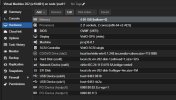Hello,
I have an Optiplex 3050 Micro with an i5-6500T, 16 GB of RAM, and (2) disks -- a 256GB NVMe and a 256 GB SATA. I stumbled across this post recently: https://forum.proxmox.com/threads/igpu-passthrough-with-intel-graphics-530.138810/
I'm running ProxMox 8.1.4, and based on the posting date I figured "hey it's probably safe to assume the op was on 8.x as well" -- I have identical hardware so the instructions should 'just work' -- I was wrong. I think in my case, because I had opted to do UEFI / ZFS (RAID-1) mirror, systemd-boot was utilized instead of GRUB -- as such, instead of modifying /etc/default/grub, I modified /etc/kernel/cmdline -- which looks as follows:
My /etc/modules:
On the ProxMox host, I ran: apt install libgl1 libegl1
I then ran: proxmox-boot-tool refresh
I rebooted.
After the reboot, cat /proc/cmdline looks perfect.
I built a W10 IoT VM, enabled RDP, ran all the updates, and powered it off. I then passed through the PCI devices (video and audio), as well as USB keyboard and mouse, changed the display to "VitIO-GPU (virtio)".
I power it on -- it boots perfectly fine. Windows detects the hardware, and everything looks great. However, when I switch over to my monitor it just sits searching for an HDMI signal. I've rebooted the ProxMox server and left it on the HDMI input. I noticed the video displays perfectly fine during POST, ProxMox booting, etc. -- I see the IP address message, and when I power on the VM -- the screen just turns black.


I'm so close. Any assistance would be greatly appreciated!
I have an Optiplex 3050 Micro with an i5-6500T, 16 GB of RAM, and (2) disks -- a 256GB NVMe and a 256 GB SATA. I stumbled across this post recently: https://forum.proxmox.com/threads/igpu-passthrough-with-intel-graphics-530.138810/
I'm running ProxMox 8.1.4, and based on the posting date I figured "hey it's probably safe to assume the op was on 8.x as well" -- I have identical hardware so the instructions should 'just work' -- I was wrong. I think in my case, because I had opted to do UEFI / ZFS (RAID-1) mirror, systemd-boot was utilized instead of GRUB -- as such, instead of modifying /etc/default/grub, I modified /etc/kernel/cmdline -- which looks as follows:
Code:
initrd=\EFI\proxmox\6.5.11-8-pve\initrd.img-6.5.11-8-pve root=ZFS=rpool/ROOT/pve-1 boot=zfs intel_iommu=on iommu=pt pcie_acs_override=downstream,multifunction initcall_blacklist=sysfb_init video=simplefb:off video=vesafb:off video=efifb:off video=vesa:off disable_vga=1 vfio_iommu_type1.allow_unsafe_interrupts=1 kvm.ignore_msrs=1 modprobe.blacklist=i915My /etc/modules:
Code:
# Modules required for PCI passthrough
vfio
vfio_iommu_type1
vfio_pci
vfio_virqfd
# Modules required for Intel GVT-g Split
# kvmgtOn the ProxMox host, I ran: apt install libgl1 libegl1
I then ran: proxmox-boot-tool refresh
I rebooted.
After the reboot, cat /proc/cmdline looks perfect.
I built a W10 IoT VM, enabled RDP, ran all the updates, and powered it off. I then passed through the PCI devices (video and audio), as well as USB keyboard and mouse, changed the display to "VitIO-GPU (virtio)".
I power it on -- it boots perfectly fine. Windows detects the hardware, and everything looks great. However, when I switch over to my monitor it just sits searching for an HDMI signal. I've rebooted the ProxMox server and left it on the HDMI input. I noticed the video displays perfectly fine during POST, ProxMox booting, etc. -- I see the IP address message, and when I power on the VM -- the screen just turns black.


I'm so close. Any assistance would be greatly appreciated!
Last edited:

